1211:
BBC Radio 5 live's chief political
correspondent John Pienaar says the atmosphere of respect and reverence
on the streets of London has been the most striking feature of the
funeral of such a divisive political figure. A few people turned their backs, he said, but the respect accorded on the streets, and the role of two Labour former prime ministers, Tony Blair and Gordon Brown in planning the funeral, tell something of her, and the place she has in the country.
Margaret Thatcher's funeral: the key pieces of commentary
Eleven Guardian contributors give their verdicts on the ceremonial funeral at St Paul's Cathedral

Michael White
On the view from inside
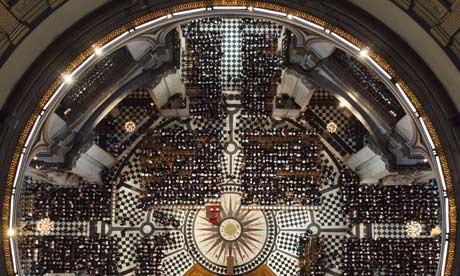
Unknown to us, Twitter went mad. Unknown to us, too, the march of the military gun carriage from St Clement Danes to England's national cathedral attracted respectable crowds, though less deep than for Churchill in 1965. As a 19-year-old-student, I was there. The grey day was much the same and there was virtually none of the predicted ("What a waste of money!") protest, shamelessly hyped by both sides.
Reporters in the eye of an event are often at a disadvantage. Those travelling through Texas with John Kennedy on that fateful day in Dallas on 22 November 1963 found themselves inside a bubble as the president's cavalcade was mysteriously delayed. In the pre-24/7 media era they became virtually the last people in America to learn he had been shot.
But the cathedral was worth the respite from the wired world of social media and rolling news TV. The music was wonderful before, during and (Elgar's Nimrod) afterwards, and the stately ceremonials – all that dressing up and flummery, military and religious – magnificent in its distinctive way. Of all the day's misplaced bits of boasting it is still true that the Brits do these things well.
There were two remarkable women inside Wren's great church, the body of Thatcher of course – no longer a stormy politician or an "ism" but "lying here, she is one of us, subject to the common destiny of all human beings", as the bishop of London, Richard Chartres, gracefully put it. The other was the Queen – just six months younger than her longest-serving prime minister – and paying rare tribute by turning up at all.
Did she look smaller than usual at the side of her husband, tall and gaunt but still standing at 91? I thought so, dressed in black and stooped as she followed officers of the church she formally heads into the cathedral at 10.50am – just before the coffin arrived. Watching her it was easy to wonder how Queen Victoria must have looked, habitually dressed in black after her own husband, Prince Albert, died young in 1861.
From the gallery it looked as if the service was conducted without the faults or errors that organisers always fear. The soldiers who gently coaxed the coffin, plus union flag and white roses, first on to the dais below the great dome, then off again, had it in their power to spoil the day with one slip. They didn't.
The day's other player with the power to make or break the mood was not a politician – cabinet ministers past and present and their rivals were reduced to walk-on parts – but Chartres. A skilful speech, I thought, and from a voice more conspicuously commanding than Justin Welby, the second man to beat him to the archbishopric of Canterbury (in a lesser role here).
Thatcher's funeral was not the time or place to debate her policies and legacies, the bishop declared, before proceeding to ignore his own advice. This was a warm and witty speech, full of emphasis on her human virtues ("Don't touch the duck pate … it's very fattening"), but also a revisionist text.
Her "no such thing as society" remark had been misunderstood, said Chartres. So it was, another politician misquoted out of pre-Leveson context. But in the process he was generous in his interpretation of her belief in "interdependence". It was a day for generosity, even tears among the faithful. But I gather Twitter was dismayed about that too. Back from St Paul's, I hope to learn more.
Jonathan Freedland
On the politics
If it's true that Margaret Thatcher's name will be remembered long into the future, these will be among the pictures that will recall her memory. A coffin draped in the union flag, borne slowly by gun carriage through a (mainly) hushed London; servicemen serving as pallbearers; the Queen standing in silent respect as a mourner; the cathedral flooding with sunlight as the doors opened for the coffin's exit; the crowds outside raising three cheers as they caught sight of it.And that's exactly what the planners of this magnificent spectacle wanted. For there will be no clue in such a montage of images that there was any controversy or doubt about such a send-off. On the contrary, future generations will gaze on this archive footage much the way we look at pictures from the 1965 funeral of Winston Churchill now: they will assume this was an uncomplicated tribute to a woman who had served as little short of a national saviour.
Which is why an all-but-state funeral was controversial, why some opposed granting such a rare, once-a-century honour to the former prime minister. For they knew, and feared, the power of such a ceremony – how it can transform and elevate a onetime partisan politician into something larger, a figure that towers above politics, apparently uniting a nation.
Once these images have aged and yellowed into archive, that's the story they will purport to tell. The boos reported as the funeral procession passed through Fleet Street were mainly off-screen. Not many will have seen the photograph of an audience of just two watching the big screen coverage of the funeral in an empty part of Leeds city centre. The funeral parties of former miners will be consigned to a footnote.
Instead, three great institutions – regularly at odds during the Thatcher era – came together to stage a lavish funeral pageant. This was a production of the Church of England, the Conservative party and the BBC, executed with the precision and class we've come to expect.
The hushed Dimbleby commentary, the soaring choral music, the gleaming military uniforms – it was as good as any royal occasion. The aim: to usher Thatcher into that tiny pantheon of figures deemed fit to stand alongside the monarchy in national esteem.
The BBC provided the gorgeous pictures, the Tory party much of the cast list – beefed up by an international contingent designed to make most leftists come out in a rash, including Dick Cheney, Henry Kissinger and Binyamin Netanyahu – with the most important words left to the church.
The sermon from the bishop of London, Richard Chartres, was well written and eloquently delivered and did its bit for the larger project, sanding down the rougher edges of the Thatcher profile, rendering it smooth enough to sit alongside Churchill, Wellington and the like.
Chartres excused the view which still inflicts most damage on her reputation. "Her later remark about there being no such thing as society has been misunderstood," he said. And, in a neat play on one of her favourite catchphrases – one she deployed for divisive ends, separating friends from foes – he declared that Thatcher was now "one of us", sharing the common destiny of all mortals.
No such normality was intended from this event. It aimed to make Thatcher anything but normal, to propel her memory into a much higher category. In this, her final journey, surely not many obstacles now stand in her way.
Giles Fraser
On the ceremony
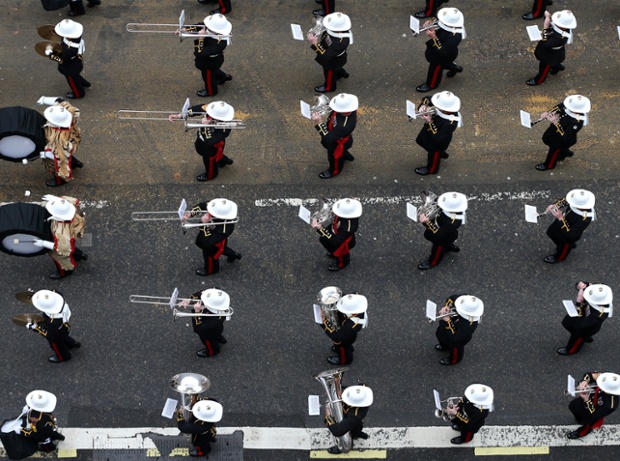
But the church ought to make an uncomfortable partner in all of this, and not allow itself to be conscripted into the spiritual arm of the Tory party. Especially as the church was one of the most vocal sources of opposition to Thatcherism during the 1980s. Indeed, it was in St Paul's that Thatcher fell out with Robert Runcie because he prayed for the Argentinians. Singing I Vow to Thee my Country – despite the second verse's qualification that nationalism is subject to a higher authority – is a poor guide to Christian reflection on her flag-waving patriotism. And He who Would Valiant Be can too easily be read as a theological defence of her stubborn "not for turning" defiance of dissent. All this jarred – and not least because the hymn choices were just a little too Magic FM.
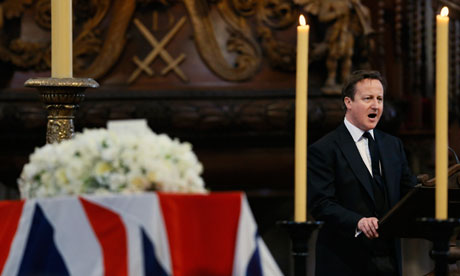
That "we are all members, one of another" and that "we do not achieve happiness or salvation in isolation from each other but as members of society" will not sound like Thatcher to the Durham miners, for instance.
Of course, the service wasn't political if by political we mean the promotion of some particular policy. But it was deeply political in the wider sense, in so far as it celebrated some apparently deep connection between the various institutions of power – military, religious, royal, political, even conscripting the generally obsequious media.
It is a bit of an irony really. She spent her political life calling for a smaller state. And yet, in the end, it was the state in all its glamour and grandeur that was the star of her own funeral.
Martin Kettle
On the music
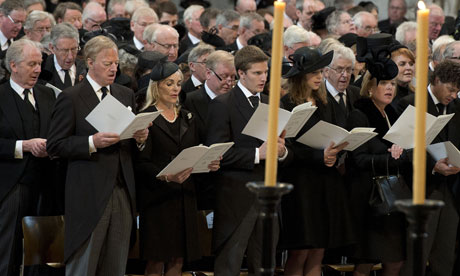
Yet at St Paul's on Wednesday, Lady Thatcher went out to the sound of music nevertheless. It was a programme she was said to have chosen herself, though one slightly suspects in most respects it was chosen for her to approve, rather than representing her own keenest personal tastes, as the hymns and readings surely did. But it was a good selection all the same.
It started and finished with English music, and that was surely very deliberate. Before the coffin made its first dramatic appearance, the west doors thrown open and the cathedral suddenly open to the London air, organists played English music from the day before yesterday — the Conservative party's comfort zone — music by composers who were born in the Victorian era but died after the Great War — John Ireland, Herbert Howells, Elgar, Stanford, Parry, the newly fashionable Frank Bridge and the public school socialist Ralph Vaughan Williams. It felt like a list drawn up by a Thatcherite fogey like Roger Scruton or Simon Heffer. The latter looked a treat in a top hat with his morning coat.
At the end, after the lessons, the hymns and the prayers — which were standard stuff — there was Elgar, in the form of William Harris's arrangement of Nimrod, one of the most emotionally powerful pieces of music ever written and, for some, an anthem of love of England. Nimrod's status as the quintessentially English piece of music, deep understated passions held manfully in check until the irresistible — and brilliantly brief — climax is unshakeable now, though it was written more as a statement of friendship for Elgar's editor, and nothing more. Quite a statement, all the same. And well orchestrated.
Music with Scottish or Irish associations did not get a look in, which probably reflected Thatcher's prejudices pretty accurately. Nor was there anything out of left-field — like Elton John's appearance at Princess Diana's funeral in 1997 — which was a pity. But Thatcher was far too conventional for that.
European music played an unexpectedly important role for Europe's Mrs No, No, No, which was a real surprise. A deathbed conversion to Europe? Unlikely. Nevertheless the choir, with one woman in an all male line-up — Thatcher would surely have identified with that — sang part of Brahms's German Requiem, bringing some good Protestant counterpoint to the occasion, but still surprising for the funeral of the prime minister who so viscerally disapproved of German unification. Thatcher never had much time for France either, but the lovely modulations of the In Paradisum from Fauré's Requiem were another reminder that the Europeans have a lot of the best tunes.
Actually being there, sitting two-thirds of the way back in the cathedral nave rather than watching it on television, you hear the planned musical programme across vast distances. But you also hear it against a background of other distant and more unplanned sounds. When the doors were thrown open, the organ music vied with solemn marches from unseen military bands playing Beethoven and Chopin out on Ludgate Hill and, above all, with the tolling of the bells – it all felt a bit like a piece by Charles Ives, in which everything gets superimposed on everything else.
When you are there, it is the little details that stick in the mind rather than the big, skillfully edited or cleverly deconstructed picture. And as the coffin was borne out of the cathedral, the most compelling of all sounds was not the organ or the singing or even the ripple of applause from out on the street, clearly audible inside, it was the strict clump and crunch of the coffin party's military boots as they carried Lady Thatcher out into the sunlight of history for one final journey.
Michael Billington
On the theatre
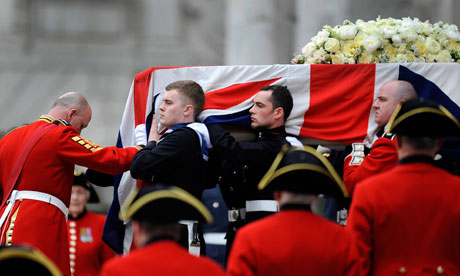
But, while the physical presentation was flawless, I felt a strange disproportion between the ceremonial grandeur of the occasion and the contentious politics of Thatcher herself. The bishop of London, in his address, sought to make a distinction between the "ism" and the individual; but if ever there was any one person in whom they were totally inseparable, I would have thought it was Margaret Thatcher.
The giveway came in David Dimbleby's invocation, at different times in his BBC commentary, of the funerals of Nelson, Wellington and Churchill. I missed the first two of those but I certainly remember Churchill's funeral: a truly solemn event in which we felt we were marking not just the death of a political leader but a turning point in the national story.
Patrick O'Donovan, in a much-quoted Observer piece, remarked that, as Churchill's coffin passed through the London streets it was "surrounded by this extraordinary silence, not of grief but of respect". In contrast, the Thatcher hearse was met with ripples of polite applause from her well-wishers. I felt I was watching an attempt to write her into the national myth rather than, as with Churchill, a piece of genuine theatre.
As with all such events, the drama lay in the detail. Thanks to the cameras, it was possible to glimpse all sorts of revealingly human moments: the sweat on the brow of a pallbearer after piloting the coffin up the steps of St Paul's; the sudden, muttered aside of the Queen to the Duke of Edinburgh as the coffin itself passed by; the concentration on the face of a boy-treble as the choir sang the anthem from the Fauré Requiem.
The camerawork throughout was astonishing, with pans round the dome of St Paul's seeming to echo the tessellated circle in which the coffin was placed. But, fascinating as it was to catch momentary close-ups of Thatcher's former colleagues such as Carrington, Heseltine, Tebbit and Hurd, I was suddenly reminded of the old, and today much less justified, joke about the Church of England being "the Tory party at prayer."
Was I moved? Very rarely. But that was because I felt I was vicariously witnessing not one of those rare moments when the British achieve a sense of national identity but the well-staged funeral of a combative ideologue. If anything did touch me it was the bishop's articulation of the idea that death is an entrance rather than an exit, which he reinforced by quoting TS Eliot's line that "the end is where we start from".
Even then, since all the spectacular pomp of the funeral seemed designed to propagate the Thatcher myth, I was reminded of an even more pungent phrase from Eliot's Four Quartets: "human kind cannot bear very much reality".
Sam Wollaston
On the TV
David Dimbleby has some time to kill before the procession leaves the Palace of Westminster. Time to talk about the route, tell us about the undertakers and the horses – six black chargers led by Mr Twister – who'll pull the gun carriage after a pit stop at St Clement Danes.And there are distinguished guests, mostly titled, in the studio overlooking St Paul's. Shirley Williams is generous, remembers the Iron Lady actually ironing, and praises her extraordinary single-mindedness and seriousness.
"What brings you here?" Dimbleby asks Terry Wogan. Sir T's not sure, he didn't know Lady T well, but he tells a story about her, Denis and a couple of gin and tonics I've heard before. Peter Hennessy, the historian, is on hand for pithiness. "She was a primary-colours politician who disturbed all the atoms in politics," he says.
Over on ITV … Oh: Jeremy Kyle. They're starting later. Back to One then, and Dimbleby's spotting faces in the crowd. Betty Boothroyd, Leon Brittan, Ken Clarke coming up the stairs, Nigel Lawson, Tony Blair, Henry Kissinger.
ITV have realised something's up. They start their coverage, anchored by Phillip Schofield and Holly Willoughby, who was aged minus two when Thatcher came to power. OK, they have ITN newsreader Alastair Stewart at St Paul's, but they're dipping in and out, going back to the studio to hear what Toby Young thinks, or to talk to Chris Evans.
The BBC it is then: you want a Dimbleby for an occasion like this, don't you? He's got the PM with him now. "I don't like to talk about opinion polls on a day like this," he tells Cameron, before going on to do just that, specifically one that shows the Tory rating surging by eight points when people were asked to imagine it was led by a youthful Maggie. Dimbleby's not neglecting his job, then, as a political journalist, even on a day like this.
He has a good funeral. The BBC cameras may have missed the Ludgate Circus protesters, but he does at least mention them. The coverage is fair, neither fawning nor aggressively disrespectful.
Once the service begins there's not an awful lot to do apart from introduce a few more people. There's one minor Fumbleby: "One of Lady Thatcher's favourite films" turns out to be one of her favourite hymns (sadly: for a moment I thought a screen would be lowered from the dome and they'd show Top Gun to the assembled dignitaries). And surely only the very, very puerile would have have been amused by, or even noticed, "Roger Gifford takes her [the Queen] up the nave."
Afterwards, there's just time for a bit more sleb-spotting – Norman Lamont, another Shirley (Bassey), Jeremy Clarkson ("I think he's very sympathetic to her politically"). The coffin is handed over to Leverton & Sons, family undertakers (founded 1789, the year of the start of the French Revolution, as it happens). And the lady inside is, as Hennessy says, handed over to the historians.
Jess Cartner-Morley
On the style
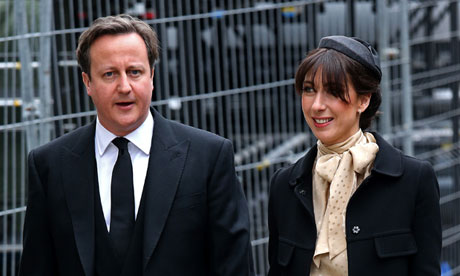
Samantha Cameron's outfit for the funeral was a direct tribute to Lady Thatcher herself. She wore a gold silk blouse with a florid pussy bow. The pussy-bow blouse is a look which Thatcher made her own. Thatcher's other style signatures – the pearls, the handbag – are part of the broader lexicon of power dressing, but a pussy-bow blouse can mean only one thing. It is unmistakably a homage to the wardrobe of her Downing Street years.
Cameron has had a high-level career in the luxury fashion industry, and is an active ambassador for British fashion. There is no doubt that she has a sophisticated understanding of sartorial nuance, and knew exactly the impact a pussy bow would have.
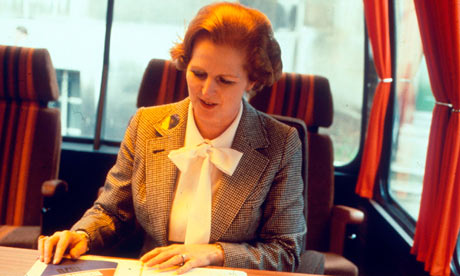
Until now, Cameron has used her wardrobe to send a message about a new, modern era of conservatism. She wears Zara shoes to party conferences, edgy British designers to state dinners, and trouser suits instead of wifely dresses. Which makes all the more striking her decision to draw such a direct connection between herself and this controversial figure.
Interesting, also, that with controversy simmering over the presence of the Queen at the funeral of a "mere" (as the BBC put it) politician, a politician's wife should put herself so boldly in the limelight. The pussy bow is a motif of Toryism, not of traditional mourning. Those who grumbled that this was a Tory state funeral might feel vindicated if the upshot of the occasion is the return of the pussy-bow blouse to newspaper front pages.
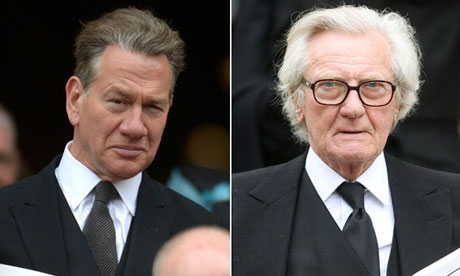
The Thatcher family were dressed in a careful show of unity. The men wore morning suits, the women A-line knee-length black coats over matching dresses, with uniform 40-denier tights. Amanda Thatcher, her face shaded by a rather old-fashioned hat, the spotless soles of her shiny new Mary Jane sandals glimpsed as she curtseyed to the Queen, was impeccably sober. No Pippa Middleton scene-stealing here. The Queen, so rarely seen in black, looked rather marvellous in her black suit and pearls, a keen reminder to the rest of us of the power which can still be invested in the wearing of black if only one didn't fritter it away by slobbing around in black jeans.
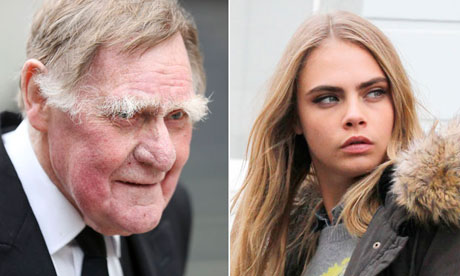
Among the women, there was a bounty of pearls. Diamonds are too flashy, unless one is the Queen, in which case a simple diamond brooch is a subtle reminder of status; pearls, being the precious jewel of the middle classes, strike the right balance. Furthermore, of course, Thatcher always wore the double-string of pearls she was given by her husband on the birth of their twins. Among the women on the front row – mostly politician's wives, media-aware and conscious that their outfits would be scrutinised – the hat style of choice was a shallow pillbox. A hat without a brim is ceremonial but not, as it were, state. (The style was also favoured by Thatcher herself in her early career, until her advisers decreed hat-wearing to be un-modern.)

Nick Hopkins
On the military
Lady Thatcher wanted her funeral to have a Falklands theme, and though no details were thrashed out before her death, the Ministry of Defence had a good idea which units would have to be involved when the planning for the ceremony began.All of the regiments taking part played an important role during the conflict in the south Atlantic – a reflection of the fact that their sacrifices, and successes, underpinned the former prime minister's significant military legacy.
Two of those who served in the Falklands were chosen to command the pallbearers: Major Nick Mott, from the Welsh Guards, and his brother Garrison Sergeant Major Bill Mott, who both survived the attack on the Sir Galahad, the supply ship and troop carrier which was attacked as it prepared to unload soldiers in Port Pleasant. Forty-eight soldiers and seamen died; many were rescued from the burning hull by helicopters.
The Motts were positioned to the left and right behind the gun carriage carrying Thatcher's coffin as it made its way to St Paul's Cathedral behind the band of the Royal Marines, one of three to take part in the ceremony.
The Motts were in charge of co-ordinating the team of 10 pallbearers; only eight actually carried the coffin, but two others were required to carry the caps of those with the weight on their shoulders.
None of the pallbearers served in the conflict. Aged 19, Guardsman Sam Williams was the youngest of the group, 11 years younger than the oldest, Lance Sergeant Paul Quayle, whose father fought in the campaign.
All of the pallbearers were chosen from units that served in the Falklands, including the Royal Marines, the Royal Artillery, the Scots Guards, the Welsh Guards, the Parachute Regiment and the Gurkhas.
On the steps of the cathedral to greet the coffin was a "lining party" made up of 18 serving soldiers and officers, and a contingent of veterans from the Royal Hospital Chelsea.
In total, more than 800 military personnel were involved in the ceremony, most of them lining the streets along the route. Defence officials said the scale reflected the involvement of all three services in battles with names that will jog memories for anyone who lived through the 1982 campaign.
The MoD said it chose the Scots Guards and Gurkhas because of their fighting at the battle of Tumbledown, the ridge close to the capital, Port Stanley; 40 Commando Regiment Royal Marines were among the first troops ashore and secured the beachhead at San Carlos; 3rd Battalion, The Parachute Regiment, was involved in attacks at Ajax Bay and on Wireless Ridge; the Royal Engineers' bomb disposal operators cleared routes, mines and booby traps; 4th Regiment Royal Artillery fired more than 12,000 shells at enemy positions in the final 12 hours of the conflict; and the Welsh Guards lost more than 30 men and suffered 70 wounded in the attack on the Sir Galahad.
Among the senior military figures to attend was the widow of the soldier whose bravery came to epitomise the close-quarter fighting during the conflict – Colonel "H" Jones, the commander of the 2nd Battalion, The Parachute Regiment.
He died during the battle of Goosegreen, attempting to overrun an entrenched machine gun position. His wife Sara was expected to be among the mourners.
Catherine Bennett
On the crowds
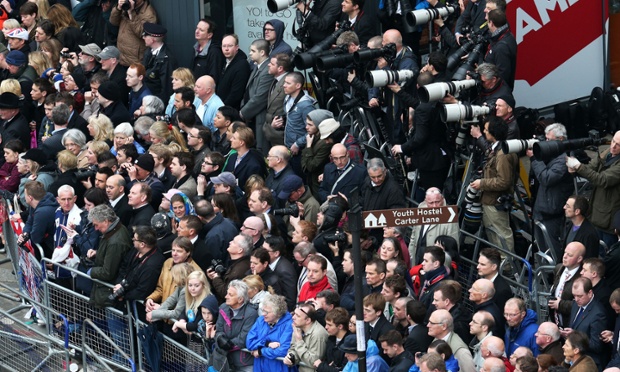
Mercifully, perhaps, given local agreement that the first woman prime minister deserved her ceremonial, this section of a muted, undemonstrative crowd was bereft of tweeters who could have told us where the real action was, on the Sam Cam hashtag, where an awed nation considered the tastefulness of parody funeral wear.
In fact it took a couple of hours at the barrier to figure out that this technological deficit was the most unusual aspect of an already atypical London crowd.
Early on, the spectators looked strikingly similar in age (50ish?) and ethnicity (overwhelmingly white), and conduct (utterly restrained), to an interval crowd of Alan Bennett-lovers at the National Theatre. Some, incredibly, had brought actual newspapers along to pass the time.
But, strangest of all, their phones only started coming out when the military arrived, and then only for photographs. It was like being on a quiet coach. Before long, if they don’t already, pictures of this tweetless, text-free audience will probably look as curious as those old V-day shots, featuring our ancestors in dark suits and vintage caps.
With the triumph of Mrs Cameron’s outfit, it became obvious that her achievement, in transforming a great funeral into something more fashion forward, would promptly be added to the list of reasons why simply being one of the most successful British women in political history does not justify anyone a costly Churchillian send off, any more than the respect of young women who come after her.
What the idiotic hat confirms, if you buy this line of argument, is that, because Thatcher only promoted one woman, and a right-wing one at that, it is irrelevant she stopped people asking, ever again, if a woman could be prime minister (though she could not, admittedly, as Russell Brand demonstrated last week, prevent them worrying who’d look after the kiddies). What does it signify, that she triumphed in an overwhelmingly hostile, male establishment, when people are still talking about another woman’s outfit.
Supposing, however, you still consider the arrival of Britain’s first women prime minister a significant achievement, then the excitement over Samantha Cameron’s and Amanda Thatcher's appearance, (the latter’s Penguin book on entertaining should be available for pre-order soon) merely confirms that Lady Thatcher’s ceremonial funeral was a necessary as well as deserved corrective.
In the festival of misogyny which followed the death of “that woman”, supporters and detractors of all classes have studied how best to reduce her to a package of pathetic absurdities, from her funny walk and noisy-sounding, yet sexy tights (Jon Snow) and her irrepressible flirting (all male colleagues), to her adorable wrists, ankles etc (John Gummer et al) and her handbaggings, affected voice, Caligula mouth, and comical larderful of grot (allowable liberal snark).
Maybe it is wrong to think there are page three girls who can only dream of Thatcherlike heights of objectification. Maybe, when “the lawyer’s son” Tony Blair, departs this world, tributes will also focus insultingly on his Caligula eyes and Marilyn Monroe manboobs. But, frankly, since we need not enlist him as the vanquisher of massive establishment misandry, who cares? Had it not been for her obsequies watched by people who had never been mercilessly flirted with, or thrilled to the seductive nylonic whisper of a Thatcher leg-crossing, then reduction of this politician to a sort of comical one-off might have been more or less the last word on Thatcher before history signed her off.
As it was, lavish honours which initially looked over the top seemed to restore some of the dignity which, had she been a man, might never have been so begrudged. Watching it, next to spectators who also wanted to honour the woman, before her policies, it was possible to see a time when other symbols might seem more significant than Thatcher’s handbag or Sam Cam’s blouse, just as the military bands and applause drowned out the earlier perving about the prime minister’s legs and sniggering over her ready meals. Although the Marxism endemic in their profession has been exposed on the highest authority, my neighbours on both sides were retired teachers, applauding their alleged nemesis. “I understand the loneliness of her position, and how hard she had to work,” said the former headteacher, a woman. “She broke the glass ceiling”.
True, there are less controversial ways of spending millions: royal weddings, jubilees and funerals, cause relatively little resentment, even though they offer negligible inspiration to large-bottomed female commoners and limited scope, unlike the divisive Mrs T, for eye-catching protest. For Thatcher-sceptics, as well as her fans, her undeserved gun-carriage offered glorious opportunities for snubbing feistiness, along the lines of Sally Bercow, dismissing social conventions with the challenge: “Last time I looked this was the 21st century!”
Maybe, as the funeral demographic suggests, to appreciate what Thatcher did to challenge the sexual conventions of the 20th century, you had to be there, in the seventies, having your ankles inspected. To paraphrase Thatcher: you can never forget, and you’re quite unlikely to forgive.
Rhiannon Lucy Cosslett
On 'the Pippa factor'
Those monitoring Margaret Thatcher's funeral on social media this morning will have seen spectators engaged in varied and diverse ways of amusing themselves, from drinking games (do a shot every time you spot a war criminal) to questioning whether David Cameron's biblical reading of "in my father's house are many mansions" was deliberately engineered (surely now is no time to be boasting, David?) But drowning out the dissent even more effectively than the lacklustre clapping on the Strand this morning were the sounds of newsroom gentlemen salivating over the image of Thatcher's 19-year-old granddaughter Amanda, close-ups of whom made it on to the Daily Mail's website at breakneck speed.As political commentator Gaby Hinsliff rightly pointed out, viewers and journalists alike clearly felt that this funeral was in desperate need of a "Pippa factor", if only to break up the tedium of what was, let's face it, a televised church service with a congregation containing a few famous faces, including a scarily ageless John Major. In other words, people were as bored as you'd expect a nation of fly-by-night lapsed Anglicans to be, so it's no wonder that they were looking around for a perv factor. It briefly looked as though a lachrymose George Osborne, who although he only met the Iron Lady once was clearly feeling a little wobbly, might upstage Amanda as the guest of choice, but as no one seemed willing to objectify him, interest waned as rapidly as Sam Cam's smirk did at the moment she realised there was a camera pointing at her.
But can we attribute this congregational scrutiny merely to boredom? Admittedly, many of us have no doubt been guilty of the odd look-around at weddings and funerals – if only to make sure that we're crying as much as everyone else. But this is about more than competitive emoting – we're talking about hacks in need of an angle, and, as the royal wedding proved, in the absence of a bomb or a protest, only a peachy female arse will do.
The jury's out as to whether "granddaughter in mourning" is a state of mind more conducive to seduction than "younger sister at wedding", but if the lecherous tweets are anything to go by, Amanda Thatcher, who it is claimed bears a passing resemblance to Renée Zellweger (and has an accent to match), fits the voyeuristic role of "top ceremonial totty" perfectly. Unless, of course, she high tails it back to America and obscurity and remains there, at a safe distance not only from the red tops but for any tips that fountain of knowledge Pippa may have to impart (today's attendees clearly heeded her advice to wear black and look sad). Let's hope, for all our sakes, that she escapes before the sidebar of shame gets itself another box and Waitrose starts looking for another columnist.
Simon Hoggart
It was, probably, the last great commemoration of politicians, for politicians, by politicians. Everything about the funeral screamed, "yes, we matter too! We can get the Queen, and the archbishop, and the choirs, and even a bunch of foreigners!"No wonder Gordon Brown was one of the few who arrived with a smile on his face, laughing and chatting as if waiting for a Raith Rovers match. The whole ceremony had been part-organised and signed off by him while he was still in Downing Street. No wonder either that much of Labour's frontbench had turned up too, including those who were years away from becoming MPs when she was forced out.
There was a sprinkling of backbenchers as well, including Keith Vaz, but then Vaz is everywhere. If man ever lands on Mars and shakes hands with the Martian leaders, Vaz will be hovering in the background, offering sound bites at dictation speed.
It was one of those funerals where, apart from the family, almost everyone was there because of who they were. Many knew her, a lot put up with her, and some liked her, though it was hard to read the tear that at one point ran down George Osborne's cheek. The employment figures? Even the three people, Michael Heseltine, Geoffrey Howe and Ken Clarke, who disposed of her with such efficient dispatch in 1990 managed to look serious rather than sorrowful, the bad fairies who had been at Snow White's christening, now assembled to apologise for the poisoned apple.
So many mourners, so many traitors! Nigel Lawson was there; his resignation as chancellor may have marked the beginning of her downward slide. Carrington, who refused not to resign over the Falklands. Many of her cabinet now look as if they were Spitting Image puppets who have been left in a forgotten props store for too long, saggy, deflated, with little need to keep up an air of glossy confidence.
John Sergeant was in the congregation, the man who held the microphone Bernard Ingham grabbed on the fatal night in Paris. John Major, first beneficiary of her departure, whom she came to despise. It was to Sergeant that she indicated her pleasure that his prime minister's questions TV ratings were so much lower than her own.
In death, we are all as one, and all crammed together. Davids Steel and Owen, not the greatest of friends, were obliged to chat for the ages before the service began. So were Boris Johnson and Michael Howard, the man who sacked him, though Boris must have been delighted by the fact that he was it seems the only politician to be cheered by the public as he walked up the steps to the cathedral, apparently fumbling in his pocket as if worried he had lost the invitation. Conceivably it was that cheer that made George Osborne cry.
A scattering of celebrities, just on the right side of "who on Earth?" Jeremy Clarkson, Joan Collins, Jeffrey Archer, even Michael Fabricant MP, his lustrous hair-style topping for once dimmed by the dazzling lights of St Paul's. And Alex Salmond, who acknowledges his gratitude; her decision to start the loathed poll tax in Scotland was a huge impetus towards the notion of national independence.
A disappointing turnout from abroad, good in numbers if low in fame. But then this was about British politics rather than international diplomacy. From America, Henry Kissinger, Newt Gingrich – surely she would have found him deeply distasteful? – and former vice-president Dick Cheney, whose poor health over eight years meant, in Garry Trudeau's words, that George W was "only a heartbeat from the presidency". But neither Bush nor Clinton and no Carter. It was hard to ignore the niggle that she was, perhaps, more world famous in Britain than she was in the rest of the world.
Photographs: © PA, Associated Press, Getty, Reuters
沒有留言:
張貼留言